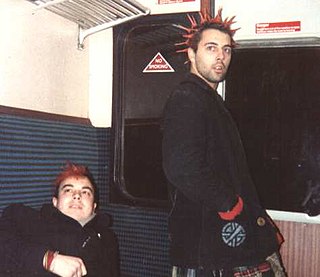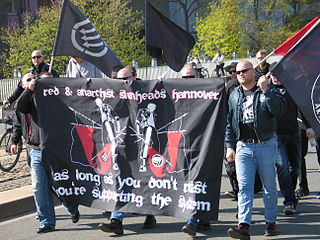
A skinhead is a member of a subculture which originated among working class youths in London, England, in the 1960s and soon spread to other parts of the United Kingdom, with a second working class skinhead movement emerging worldwide in the late 1970s. Motivated by social alienation and working class solidarity, skinheads are defined by their close-cropped or shaven heads and working-class clothing such as Dr. Martens and steel toe work boots, braces, high rise and varying length straight-leg jeans, and button-down collar shirts, usually slim fitting in check or plain. The movement reached a peak at the end of the 1960s, experienced a revival in the 1980s, and, since then, has endured in multiple contexts worldwide.

Punk fashion is the clothing, hairstyles, cosmetics, jewellery, and body modifications of the punk counterculture. Punk fashion varies widely, ranging from Vivienne Westwood designs to styles modeled on bands like The Exploited to the dressed-down look of North American hardcore. The distinct social dress of other subcultures and art movements, including glam rock, skinheads, greasers, and mods have influenced punk fashion. Punk fashion has likewise influenced the styles of these groups, as well as those of popular culture. Many punks use clothing as a way of making a statement.

A parka or anorak is a type of coat with a hood, often lined with fur or faux fur. This kind of garment is a staple of Inuit clothing, traditionally made from caribou or seal skin, for hunting and kayaking in the frigid Arctic. Some Inuit anoraks require regular coating with fish oil to retain their water resistance.

Mods and rockers were two conflicting British youth subcultures of the 1950s and 1960s. Media coverage of mods and rockers fighting in 1964 sparked a moral panic about British youth, and the two groups became widely perceived as violent, unruly troublemakers.

Skinheads Against Racial Prejudice (SHARP) are anti-racist skinheads who oppose white power skinheads, neo-fascists and other political racists, particularly if they identify themselves as skinheads. SHARPs aim to reclaim the original multicultural identity of the original skinheads, hijacked by white power skinheads, who they sometimes deride as "boneheads".
Rude boy, rudeboy, rudie, rudi, and rudy are slang terms that originated in 1960s Jamaican street culture, and that are still used today. In the late 1970s, there was a revival in England of the terms rude boy and rude girl, among other variations, being used to describe fans of two-tone ska. The use of these terms moved into the more contemporary ska punk movement as well. In the UK, the terms rude boy and rude girl are used in a way similar to gangsta, yardie or badman.

Mod, from the word modernist, is a subculture that began in London and spread throughout Great Britain and elsewhere, eventually influencing fashions and trends in other countries, and continues today on a smaller scale. Focused on music and fashion, the subculture has its roots in a small group of stylish London-based young men in the late 1950s who were termed modernists because they listened to modern jazz. Elements of the mod subculture include fashion ; music and motor scooters. In the mid-1960s, the subculture listened to power pop rock groups with mod following, such as the Who and Small Faces, after the peak Mod era. The original mod scene was associated with amphetamine-jazz fuelled all-night dancing at clubs.
The 20th century saw the rise and fall of many subcultures.

Rockers, leather boys, Ton-up boys, and possibly café racers are members of a biker subculture that originated in the United Kingdom during the 1950s. It was mainly centred on British motorcycles and rock 'n' roll music. By 1965, the term greaser had also been introduced to the UK, and, since then, the terms greaser and rocker have become synonymous within the British Isles although used differently in North America and elsewhere. Rockers were also derisively known as Coffee Bar Cowboys. Their Japanese counterpart was called the Kaminari-Zoku.

A cutdown is a customised scooter with parts of the bodywork removed or cut away. Cutdowns were popular amongst skinheads and scooterboys during the mod revival of the 1970s and 1980s. While the style-obsessed British mod youth subculture of the 1960s prized the glamorous, metropolitan image of scooters, many skinheads and scooterboys viewed their bikes as simply a form of transportation.

In the context of the skinhead subculture, a redskin is a Marxist skinhead, who often also subscribe to anarchist views. The term combines the word red, with the word skin, which is short for skinhead. Redskins take a militant anti-fascist and pro-working class stance.
The mod revival was a subculture that started in the United Kingdom in the late 1970s and later spread to other countries. The mod revival's mainstream popularity was relatively short, although its influence lasted for decades. The mod revival post-dated a Teddy Boy revival, and mod revivalists sometimes clashed with Teddy Boy revivalists, skinhead revivalists, casuals, punks and rival gang members.

Trojan skinheads are individuals who identify with the original British skinhead subculture of the middle 1960s, when ska, rocksteady, reggae, and soul music were popular, and there was a heavy emphasis on mod-influenced clothing styles. Named after the record label Trojan Records, these skinheads identify with the subculture's Jamaican rude boy and British working class roots.

Fashion of the 1980s was characterized by a rejection of 1970s fashion. Punk fashion began as a reaction against both the hippie movement of the past decades and the materialist values of the current decade. The first half of the decade was relatively tame in comparison to the second half, which was when apparel became very bright and vivid in appearance.

In a decade that broke many traditions, adopted new cultures, and launched a new age of social movements, 1960s fashion had a nonconformist but stylish, trendy touch. Around the middle of the decade, new styles started to emerge from small villages and cities into urban centers, receiving media publicity, influencing haute couture creations of elite designers and the mass-market clothing manufacturers. Examples include the mini skirt, culottes, go-go boots, and more experimental fashions, less often seen on the street, such as curved PVC dresses and other PVC clothes.
Alternative fashion or Alt fashion is fashion that stands apart from mainstream commercial fashion. Alternative fashion includes the fashions of specific subcultures such as emo, scene, goth subculture, hip hop, cyberpunk, kawaii, cottagecore, goblincore, 70's core, and Lolita fashion; however, it is not limited to these. In general, alternative, or 'alt', fashion does not conform to widely popular style trends of the times that have widespread popularity. It may exhibit itself as a fringe style – extremely attention-grabbing and more artistic than practical – but it can also develop from anti-fashion sentiments that focus on simplistic utilitarian drives.

'Hoxton' Tom McCourt is the former bassist and bandleader of punk rock/Oi! band, The 4-Skins. He was one of the most influential members of the skinhead revival of 1977 to 1978, the mod revival of 1978 to 1979 and the Oi! movement from 1979 to 1984.

Hardcore skinheads are skinheads who mainly associate with hardcore and sometimes heavy metal instead of Oi!, ska, soul or other music genres associated with the skinhead subculture.
Subculture: The Meaning of Style is a 1979 book by Dick Hebdige, focusing on Britain's postwar youth subculture styles as symbolic forms of resistance. Drawing from Marxist theorists, literary critics, French structuralists, and American sociologists, Hebdige presents a model for analyzing youth subcultures. While Hebdige argues that each subculture undergoes the same trajectory, he outlines the individual style differences of specific subcultures, such as Teddy boys, mods, rockers, skinheads, and punks. Hebdige emphasizes the historical, class, race, and socioeconomic conditions that surrounded the formation of each subculture. While Subculture: The Meaning of Style is one of the most influential books on the theory of subcultures, it faces a range of critiques.













